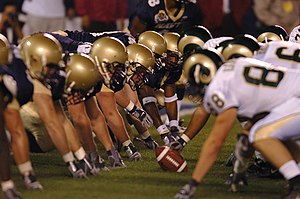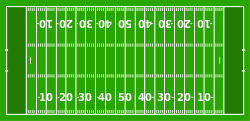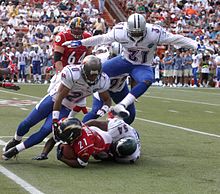|
|
|---|
Thursday, October 7, 2010
American football and it's history
For other uses, see American football (disambiguation).
 |
| Add caption |
The U.S. Naval Academy Midshipmen (left) face off against the Colorado State Rams. Nickname(s) Football, Tackle football, Gridiron First played November 6, 1869, Rutgers vs. Princeton Characteristics Contact Full contact Team members 11 at a time Categorization Outdoor Equipment Football Olympic No American football, known in the United States as football, is a sport played between two teams of eleven. The objective of the game is to score points by advancing the ball into the opposing team's end zone. The ball can be advanced by running with it or throwing it to a teammate. Points can be scored by carrying the ball over the opponent's goal line, catching a pass thrown over that goal line, kicking the ball through the opponent's goal posts or tackling an opposing ball carrier in his own end zone.
American football is closely related to Canadian football but with some differences in rules and in the configuration of the field, in particular the presence of eleven players on the field rather than twelve and the allowance of four downs per possession rather than just three. The larger number of downs results in more offensive rushing in American football than in the Canadian game.
In the United States, the major forms are high school football, college football and professional football, which are essentially similar but feature slightly different rules.
High school football is governed in the U.S. by the National Federation of State High School Associations. College football is governed in the U.S. by two bodies: the National Collegiate Athletic Association and the National Association of Intercollegiate Athletics. The major league for professional football is the National Football League. Over the years, there have been other notable professional football leagues, including the All America Football Conference during the 1940s, the American Football League during the 1960s, the United States Football League during the 1980s, and the currently active United Football League.
The sport is also played outside the United States. National and collegiate leagues exist in the United Kingdom, Germany, Italy, Switzerland, Finland, Sweden, Japan, Mexico, Israel, Spain, Austria, and several other European, American, Asian and Pacific Island nations. The International Federation of American Football acts as an international governing body for the sport on five continents, but the organization has little standing in the United States compared to the aforementioned bodies and leagues.
History-
Main article: History of American football

An American football team at the turn of the twentieth century. Note the continued use of a rugby-type ball (front row, right).

Walter Camp
The popularity of collegiate football grew as it became the dominant version of the sport for the first half of the twentieth century. Bowl games, a college football tradition, attracted a national audience for collegiate teams. Bolstered by fierce rivalries, college football still holds widespread appeal in the US.
The origin of professional football can be traced back to 1892, with William "Pudge" Heffelfinger's $500 contract to play in a game for the Allegheny Athletic Association against the Pittsburgh Athletic Club. The first Professional "league" was the Ohio League, formed in 1903, and the first Professional Football championship game was between the Buffalo Prospects and the Canton Bulldogs in 1919. In 1920, the American Professional Football Association was formed. The first game was played in Dayton, Ohio on October 3, 1920 with the host Triangles defeating the Columbus Panhandles 14–0. The league changed its name to the National Football League (NFL) two years later, and eventually became the major league of American football. Initially a sport of Midwestern industrial towns in the United States, professional football eventually became a national phenomenon. Football's increasing popularity is usually traced to the 1958 NFL Championship Game, a contest that has been dubbed the "Greatest Game Ever Played". A rival league to the NFL, the American Football League (AFL), began play in 1960; the pressure it put on the senior league led to a merger between the two leagues and the creation of the Super Bowl, which has become the most watched television event in the United States on an annual basis.
Rules:
Main article: American football rules
Field and players-

The numbers on the field indicate the number of yards to the nearest end zone.
Yard lines cross the field every 5 yards (4.6 m), and are numbered every 10 yards from each goal line to the 50-yard line, or midfield (similar to a typical rugby league field). Two rows of short lines, known as inbounds lines or hash marks, run at 1-yard (91.4 cm) intervals perpendicular to the sidelines near the middle of the field. All plays start with the ball on or between the hash marks. Because of the arrangement of the lines, the field is occasionally referred to as a gridiron in a reference to the cooking grill with a similar pattern of lines.
At the back of each end zone are two goalposts (also called uprights) connected by a crossbar 10 feet (3.05 m) from the ground. For high skill levels, the posts are 18 feet 6 inches (5.64 m) apart. For lower skill levels, these are widened to 23 feet 4 inches (7.11 m).
Each team has 11 players on the field at a time. Usually there are many more players off the field. There are 45 active players on an NFL team. However, if time allows, teams may substitute for any or all of their players during the breaks between plays. As a result, players have very specialized roles and are divided into three separate units: the offense, the defense and the special teams. Although this is rare, in some games, almost all of the players will play during the course of the game.
Game duration-
A standard football game consists of four 15-minute quarters (12-minute quarters in high-school football and often shorter at lower levels), with a 12-minute half-time intermission after the second quarter. The clock stops after certain plays; therefore, a game can last considerably longer (often more than three hours in real time), and if a game is broadcast on television, TV timeouts are taken at certain intervals of the game to broadcast commercials outside of game action. If an NFL game is tied after four quarters, the teams play an additional period lasting up to 15 minutes. In a regular season NFL overtime game, the first team that scores wins, even if the other team does not get a possession; this is referred to as sudden death. However, in a post-season NFL game during the playoffs, if the first team with possession scores only a field goal, the other team is allowed the opportunity to match or better this score. This rule only affects playoff games in overtime in which the first team with possession scores a field goal: if the first team with possession scores a touchdown, the sudden death rules take effect. In a regular-season NFL game, if neither team scores in overtime, the game is a tie. In an NFL playoff game, additional overtime periods are played, as needed, to determine a winner. College overtime rules are more complicated and are described in Overtime (sport).
A line of scrimmage on the 48-yard line. The offense is on the left.

A quarterback searching for opportunity to throw a pass.

A running back being tackled when he tries to run with the ball.

A quarterback preparing to throw a pass.

Forward pass in progress, during practice.

A kicker attempts an extra point.
Advancing the ball-
Advancing the ball in American football resembles the six-tackle rule and the play-the-ball in rugby league. The team that takes possession of the ball (the offense) has four attempts, called downs, in which to advance the ball at least 10 yards (9.1 m) toward their opponent's (the defense's) end zone. When the offense succeeds in gaining at least 10 yards, it gets a first down, meaning the team starts a new set of four downs to gain yet another 10 yards or to score. If the offense fails to gain a first down (10 yards) after four downs, the other team gets possession of the ball at the point where the fourth down ended, beginning with their first down to advance the ball in the opposite direction.Except at the beginning of halves and after scores, the ball is always put into play by a snap. Offensive players line up facing defensive players at the line of scrimmage (the position on the field where the play begins). One offensive player, the center, then passes (or "snaps") the ball backwards between his legs to a teammate behind him, usually the quarterback.
Players can then advance the ball in two ways:
- By running with the ball, also known as rushing.
- By throwing the ball to a teammate, known as a pass or as passing the football. If the pass is thrown down-field, it is known as a forward pass. The forward pass is a key factor distinguishing American and Canadian football from other football sports. The offense can throw the ball forward only once during a down and only from behind the line of scrimmage. However, the ball can be handed-off to another player or thrown, pitched, or tossed sideways or backwards (a lateral pass) at any time.
- The player with the ball is forced to the ground (a tackle) or has his forward progress halted by members of the other team (as determined by an official).
- A forward pass flies beyond the dimensions of the field (out of bounds) or touches the ground before it is caught. This is known as an incomplete pass. The ball is returned to the most recent line of scrimmage for the next down.
- The ball or the player with the ball goes out of bounds.
- A team scores.
Before each down, each team chooses a play, or coordinated movements and actions, that the players should follow on a down. Sometimes, downs themselves are referred to as "plays."
Change of possession-
The offense maintains possession of the ball unless one of the following things occurs:- The team fails to get a first down— i.e., in four downs they fail to move the ball past a line 10 yards ahead of where they got their last first down. The defensive team takes over the ball at the spot where the 4th-down play ends. A change of possession in this manner is commonly called a turnover on downs.
- The offense scores a touchdown or field goal. The team that scored then kicks the ball to the other team in a special play called a kickoff.
- The offense punts the ball to the defense. A punt is a kick in which a player drops the ball and kicks it before it hits the ground. Punts are nearly always made on fourth down, when the offensive team does not want to risk giving up the ball to the other team at its current spot on the field (through a failed attempt to make a first down) and feels it is too far from the other team's goal posts to attempt a field goal.
- A defensive player catches a forward pass. This is called an interception, and the player who makes the interception can run with the ball until he is tackled, forced out of bounds, or scores.
- An offensive player drops the ball (a fumble) and a defensive player picks it up. As with interceptions, a player recovering a fumble can run with the ball until tackled, forced out of bounds, or scores. Backward passes that are not caught do not cause the down to end like incomplete forward passes do; instead the ball is still live as if it had been fumbled. Lost fumbles and interceptions are together known as turnovers.
- The offensive team misses a field goal attempt. The defensive team gets the ball at the spot where the previous play began (or, in the NFL, at the spot of the kick). If the unsuccessful kick was attempted from within 20 yards (18.3 m) of the end zone, the other team gets the ball at its own 20 yard line (that is, 20 yards from the end zone). If a field goal is missed or blocked and the ball remains in the field of play, a defensive player may pick up the ball and attempt to advance it.
- While in his own end zone, an offensive ball carrier is tackled, forced out of bounds, loses the ball out of bounds, or the offense commits certain fouls. This fairly rare occurrence is called a safety.
- An offensive ball carrier fumbles the ball forward into the opposing end zone, and then the ball goes out of bounds. This extremely rare occurrence leads to a touchback, with the ball going over to the opposing team at their 20 yard line (Note that touchbacks during non-offensive special teams plays, such as punts and kickoffs, are quite common).
Scoring-
A team scores points by the following plays:- A touchdown (TD) is worth 6 points. It is scored when a player runs the ball into or catches a pass in his opponent's end zone. A touchdown is analogous to a try in rugby. Unlike rugby, a player does not have to touch the ball to the ground to score; a touchdown is scored any time a player has possession of the ball while the ball is on or beyond the opponents' goal line (or the plane above it).
- After a touchdown, the scoring team attempts a try (which is also analogous to the conversion in rugby). The ball is placed at the other team's 3-yard (2.7 m) line (the 2-yard (1.8 m) line in the NFL). The team can attempt to kick it over the crossbar and through the goal posts in the manner of a field goal for 1 point (an extra point or point-after touchdown (PAT)), or run or pass it into the end zone in the manner of a touchdown for 2 points (a two-point conversion). In college football, if the defense intercepts or recovers a fumble during a one or two point conversion attempt and returns it to the opposing end zone, the defensive team is awarded the two points.
- A field goal (FG) is worth 3 points, and it is scored by kicking the ball over the crossbar and through the goal posts (uprights). Field goals may be placekicked (kicked when the ball is held vertically against the ground by a teammate) or drop-kicked (extremely uncommon in the modern game, with only two successes in sixty-plus years in the NFL). A field goal is usually attempted on fourth down instead of a punt when the ball is close to the opponent's goal line, or, when there is little or no time left to otherwise score.
- A safety, worth 2 points, is scored by the opposing team when the team in possession at the end of a down is responsible for the ball becoming dead behind its own goal line. For instance, a safety is scored by the defense if an offensive player is tackled, goes out of bounds, or fumbles the ball out of bounds in his own end zone. Safeties are relatively rare. Note that, though even more rare, the team initially on offense during a down can score a safety if a player of the original defense gains possession of the ball in front of his own goal line and then carries the ball or fumbles it into his own end zone where it becomes dead. However, if the ball becomes dead behind the goal line of the team in possession and its opponent is responsible for the ball being there (for instance, if the defense intercepts a forward pass in its own end zone and the ball becomes dead before the ball is advanced out of the end zone) it is a touchback: no points are scored and the team last in possession keeps possession with a first down at its own 20 yard line. In amateur football, in the extremely rare instance that a safety is scored on a try, it is worth only 1 point.
From Wikipedia-
0 Comments:
Subscribe to:
Post Comments (Atom)















